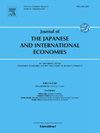Pension reform for an aging Japan: Welfare and demographic dynamics
IF 3.1
3区 经济学
Q1 ECONOMICS
Journal of the Japanese and International Economies
Pub Date : 2025-08-30
DOI:10.1016/j.jjie.2025.101390
引用次数: 0
Abstract
Japan’s life expectancy exceeds that of other developed countries; however, the standard starting age for receiving public pension benefits remains at 65 years. This paper uses an extended lifecycle general equilibrium model with endogenous fertility to investigate how a higher starting age for pension benefits affects individual welfare and future demographic dynamics. Our simulation analysis indicates that per-capita welfare will increase if the starting age for pension benefits is raised to 68 or 70. The higher the employment rate of individuals aged 65 and older, the higher are the per-capita welfare and the future population level. Conversely, if the employment rate for older adults remains at 52% (Japan’s current level), the total population would decrease in the long run compared with the benchmark case with a starting age of 65 for pension benefits. The findings demonstrate the importance of enhancing the employment rate of older adults while raising the standard pensionable age in Japan.
老龄化日本的养老金改革:福利和人口动态
日本人的预期寿命超过了其他发达国家;然而,领取公共养老金的标准起始年龄仍然是65岁。本文使用一个具有内生生育率的扩展生命周期一般均衡模型来研究提高养老金起始年龄对个人福利和未来人口动态的影响。我们的模拟分析表明,如果领取养老金的起始年龄提高到68岁或70岁,人均福利将会增加。65岁及以上老人的就业率越高,人均福利和未来人口水平越高。相反,如果老年人的就业率保持在52%(日本目前的水平),从长远来看,与65岁开始领取养老金的基准情况相比,总人口将减少。研究结果表明,在提高日本领取养老金标准年龄的同时,提高老年人就业率的重要性。
本文章由计算机程序翻译,如有差异,请以英文原文为准。
求助全文
约1分钟内获得全文
求助全文
来源期刊
CiteScore
5.10
自引率
6.90%
发文量
36
期刊介绍:
The Journal of the Japanese and International Economies publishes original reports of research devoted to academic analyses of the Japanese economy and its interdependence on other national economies. The Journal also features articles that present related theoretical, empirical, and comparative analyses with their policy implications. Book reviews are also published.

 求助内容:
求助内容: 应助结果提醒方式:
应助结果提醒方式:


